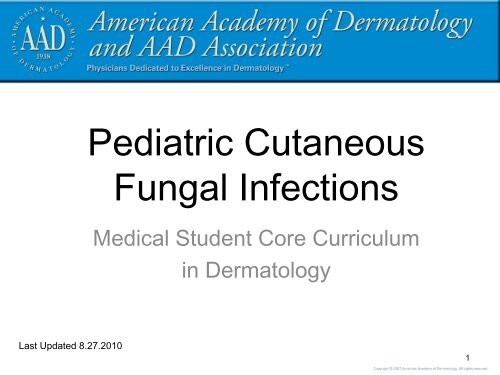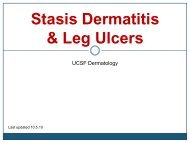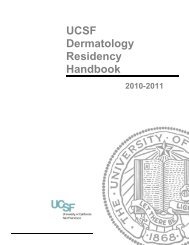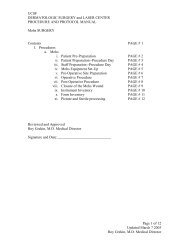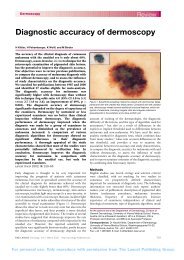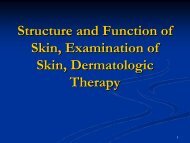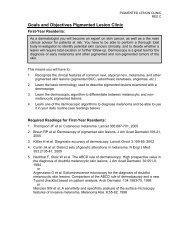Pediatric Cutaneous Fungal Infections - Dermatology
Pediatric Cutaneous Fungal Infections - Dermatology
Pediatric Cutaneous Fungal Infections - Dermatology
Create successful ePaper yourself
Turn your PDF publications into a flip-book with our unique Google optimized e-Paper software.
Last Updated 8.27.2010<br />
<strong>Pediatric</strong> <strong>Cutaneous</strong><br />
<strong>Fungal</strong> <strong>Infections</strong><br />
Medical Student Core Curriculum<br />
in <strong>Dermatology</strong><br />
1
Module Instructions<br />
The following module contains a number<br />
of blue, underlined terms which are<br />
hyperlinked to the dermatology glossary,<br />
an illustrated interactive guide to clinical<br />
dermatology and dermatopathology.<br />
We encourage the learner to read all the<br />
hyperlinked information.<br />
2
Goals and Objectives<br />
The purpose of this module is to help medical students<br />
develop a clinical approach to the evaluation and initial<br />
management of pediatric patients presenting with cutaneous<br />
fungal infections.<br />
After completing this module, the learner will be able to:<br />
• Identify and describe the morphologies of pediatric superficial fungal<br />
infections<br />
• Describe the clinical presentation of tinea capitis<br />
• Name important history items and risk factors for diaper dermatitis<br />
• Recognize the different clinical patterns of diaper candidiasis and<br />
irritant diaper dermatitis<br />
• Explain basic principles of treatment for superficial dermatomycoses,<br />
including patient education<br />
3
<strong>Pediatric</strong> Superficial<br />
<strong>Fungal</strong> <strong>Infections</strong><br />
Superficial fungal infections are limited to the epidermis, as<br />
opposed to systemic fungal infections<br />
Three groups of cutaneous fungi cause superficial infections:<br />
dermatophytes, Malassezia spp., and Candida spp.<br />
The term tinea is used for dermatophytoses and is modified<br />
according to the anatomic site of infection, e.g., tinea pedis<br />
The most common cutaneous fungal infections in children<br />
differ from those in adults.<br />
• Diaper dermatitis is the most common dermatologic condition in<br />
infants, diagnosed in approximately 1 million pediatric outpatient<br />
visits annually<br />
• Tinea capitis is the most common dermatologic disorder in school-<br />
aged children in the US, where the vast majority of cases are<br />
caused by the dermatophyte Tricophyton tonsurans<br />
4
Case One<br />
Billy Smith<br />
5
Case One: History<br />
HPI: Billy Smith is an 8 year-old healthy boy who presents to<br />
your clinic with his mother. His mother tells you that Billy has<br />
been losing his hair in patches over the last several weeks.<br />
PMH: all vaccinations up to date, no chronic illnesses or prior<br />
hospitalizations<br />
Medications: none<br />
Allergies: no known allergies<br />
Family History: noncontributory<br />
Social History: lives at home with parents and 4 year-old sister<br />
ROS: negative<br />
6
How would you describe<br />
these exam findings?<br />
Case One: Skin Exam<br />
7
Multiple patchy<br />
alopecic areas of<br />
different sizes and<br />
shapes<br />
Hair shafts are<br />
broken off near the<br />
scalp surface<br />
Case One: Skin Exam<br />
8
Case One, Question 1<br />
Which of the following is the most<br />
appropriate next step?<br />
a. KOH exam or fungal culture<br />
b. Wood’s light exam<br />
c. Begin treatment with topical antifungals<br />
d. Biopsy affected scalp<br />
9
Answer: f<br />
<br />
Case One, Question 1<br />
Which of the following is the most appropriate next<br />
step?<br />
a. KOH exam and <strong>Fungal</strong> culture<br />
b. Wood’s light exam (the likely organism for this<br />
infection will not fluoresce)<br />
c. Begin treatment with topical antifungals (does not<br />
respond fully to topicals; oral antifungals are required<br />
for treatment)<br />
d. Biopsy affected scalp (if fungal culture and KOH<br />
exam are repeatedly negative, skin biopsy may be<br />
considered)<br />
10
What are the<br />
diagnostic features<br />
in this KOH exam<br />
from infected hair?<br />
KOH Exam<br />
11
Septate hyphae with<br />
parallel walls<br />
throughout entire<br />
length<br />
Arthrospores (spores<br />
produced by<br />
breaking off from<br />
hyphae)<br />
KOH Exam<br />
12
Diagnosis: Tinea Capitis<br />
Tinea capitis is a dermatophytosis of the scalp and<br />
associated hair<br />
Majority of cases in the US are caused by the<br />
dermatophyte Tricophyton tonsurans<br />
• The most common cause worldwide is Microsporum canis<br />
Spread through direct contact with animals, humans<br />
and fomites<br />
• Fomite transmission is via shared hair brushes, caps,<br />
combs, helmets, pillows and other inanimate objects<br />
which may have spores with the potential to spread<br />
infection.<br />
Common in inner city African American children<br />
13
Tinea Capitis: Clinical Presentation<br />
Tinea capitis may be non-inflammatory (black dot,<br />
seborrheic), inflammatory (kerion) or a combination of both<br />
Broken hairs are a prominent feature<br />
Often presents with postauricular, posterior cervical, or<br />
occipital lymphadenopathy, which are less common in<br />
seborrheic dermatitis and alopecia areata<br />
Differential diagnosis of tinea capitis includes:<br />
• Seborrheic dermatitis (erythema and greasy scale but no broken<br />
hair)<br />
• Psoriasis (erythematous plaques with overlying silvery scale)<br />
• Atopic dermatitis (eczematous skin lesions, severe itching and<br />
occasional broken hairs from scratching)<br />
• Alopecia areata (well-demarcated, circular patches of complete hair<br />
loss)
Noninflammatory Tinea Capitis<br />
Seborrheic variant<br />
Variants<br />
“Black dot” variant<br />
15
Inflammatory Tinea Capitis: Kerion<br />
A kerion is a painful inflammatory,<br />
boggy mass with broken hair follicles<br />
A significant percentage of<br />
untreated tinea capitis will progress<br />
to a kerion<br />
May have areas discharging pus,<br />
frequently confused with bacterial<br />
infection<br />
Kerion carries a higher risk of<br />
scarring than other forms of tinea<br />
capitis<br />
Expeditious referral to<br />
dermatologist (i.e. within one week)<br />
is recommended<br />
16
Case One, Question 2<br />
Tinea capitis is most common in which of<br />
the following age groups?<br />
a. 0-4 years<br />
b. 4-14 years<br />
c. 15-24 years<br />
d. 25-40 years<br />
e. 65 years and older<br />
17
Answer: b<br />
<br />
Case One, Question 2<br />
Tinea capitis is most common in which of the<br />
following age groups?<br />
a. 0-4 years (seborrheic dermatitis is more common in infants<br />
and tinea capitis is more common in school-aged children)<br />
b. 4-14 years<br />
c. 15-24 years (less prevalent, but still seen in this group)<br />
d. 25-40 years (uncommon in adults)<br />
e. 65 years and older (uncommon in elderly)<br />
18
Tinea Capitis: Treatment<br />
Topical agents are ineffective in the management of<br />
tinea capitis.<br />
Griseofulvin is the drug of choice in the United<br />
States.<br />
Terbinafine granules* have been shown to be<br />
comparable in safety and efficacy to griseofulvin.<br />
• Shorter treatment course<br />
• More effective against M. canis (main cause outside<br />
U.S.)<br />
* This is a different formulation than the oral terbinafine used in adult patients for dermatophyte infections<br />
19
Case Two<br />
Karla Daley<br />
20
Case Two: History<br />
HPI: Karla is a 4 month-old healthy female infant<br />
who presents with a one week history of a bright red<br />
rash in her diaper area<br />
PMH: uncomplicated spontaneous vaginal delivery,<br />
vaccinations and well child visits are up to date<br />
Medications: None<br />
Allergies: None<br />
Social History: lives at home with parents, only child<br />
21
Case Two, Question 1<br />
Which elements of the history are important to<br />
ask in this case?<br />
a. prior history of skin disease<br />
b. therapies used to treat rash<br />
c. recent or current diarrhea<br />
d. frequency of diaper changes<br />
e. all of the above<br />
22
Answer: f<br />
<br />
Case Two, Question 1<br />
Which elements of the history are important to ask in<br />
this case?<br />
b. prior history of skin disease (Consider seborrheic<br />
dermatitis, atopic dermatitis, infantile psoriasis)<br />
c. therapies used to treat rash (Has the diaper dermatitis<br />
improved with certain medications or barrier creams?)<br />
d. recent or current diarrhea (Recent diarrhea may contribute<br />
to the development of irritant diaper dermatitis)<br />
e. frequency of diaper changes (Wet and dirty diapers that are<br />
not changed on a regular basis contribute to the development<br />
of diaper dermatitis)<br />
f. all of the above<br />
23
Case Two: Skin Exam<br />
Further questioning reveals<br />
that the Karla’s caretaker has<br />
tried applying zinc oxide diaper<br />
paste with every diaper change<br />
but the rash is not improving.<br />
How would you describe these<br />
exam findings?<br />
24
Case Two: Skin Exam<br />
Beefy red plaques with very<br />
fine white scale in the groin<br />
area<br />
Skin creases are involved<br />
Satellite papules and<br />
pustules are noted on the inner<br />
thigh and abdomen<br />
25
Case Two, Question 2<br />
Which of the following is the most likely<br />
diagnosis?<br />
a. Irritant diaper dermatitis<br />
b. Tinea cruris<br />
c. Atopic dermatitis<br />
d. Diaper candidiasis<br />
e. Infantile psoriasis<br />
26
Answer: d<br />
<br />
Case Two, Question 2<br />
Which of the following is the most likely diagnosis?<br />
a. Irritant diaper dermatitis (would have expected improvement with<br />
a barrier cream)<br />
b. Tinea cruris (well-demarcated red/brown/tan plaques, inguinal<br />
folds are affected, rarely involves labia, scrotum or penis)<br />
c. Atopic dermatitis (red skin on an edematous surface with<br />
microvesiculation, very rare in diaper area)<br />
d. Diaper candidiasis<br />
e. Infantile psoriasis (sharply demarcated, erythematous papules<br />
and plaques involving the folds)<br />
27
Diaper Candidiasis<br />
Beefy red confluent erosions and marginal scaling<br />
in the area covered by a diaper in an infant.<br />
Satellite papules and pustules help differentiate<br />
candidal diaper dermatitis from other eruptions in<br />
the diaper area<br />
Suspect diaper candidiasis when rash does not<br />
improve with application of barrier creams such as<br />
zinc oxide paste, petrolatum, triple paste, etc.<br />
28
Diaper Candiasis: Pathogenesis<br />
Urease enzymes present in feces release<br />
ammonia from the urine, causing an acute<br />
irritant effect<br />
Disruption of the epidermal barrier allows the<br />
entry of Candida which is present in feces<br />
Wet and dirty diapers that are not changed on a<br />
regular basis contribute to the development of<br />
diaper dermatitis
Classification of Diaper<br />
Dermatitis<br />
Eruptions due to the diaper environment<br />
• Irritant contact dermatitis (“ammoniacal” dermatitis)<br />
Eruptions exacerbated by the diaper environment<br />
• Inflammatory conditions (seborrheic dermatitis, atopic<br />
dermatitis, infantile psoriasis)<br />
• Infectious conditions (candidiasis)<br />
Eruptions not due to diaper environment<br />
• Nutritional deficiency (usually zinc)<br />
• Many other rare secondary causes<br />
30
Diaper Candidiasis: Topical<br />
Treatment<br />
Nystatin cream or ointment is inexpensive and effective,<br />
as are clotrimazole and miconazole<br />
• Imidazoles may be irritating when used in a cream base<br />
If inflammation is evident, hydrocortisone 1% cream or<br />
ointment may be added, however only for a limited time<br />
due to risk of skin atrophy and/or systemic absorption<br />
with prolonged use under occlusion<br />
Never prescribe combination therapies with high<br />
potency topical steroids (e.g. betamethasone/<br />
clotrimazole combination)<br />
31
Diaper Candidiasis: Oral Treatment<br />
Oral treatment – much less commonly used<br />
• Oral nystatin suspension can be added to the<br />
regimen if there is oral thrush, if the rash is peri-anal,<br />
or if it recurs quickly after treatment.<br />
Refractory diaper dermatitis may be a marker of<br />
an underlying serious metabolic or immunologic<br />
disease. Examples include:<br />
• Zinc deficiency<br />
• Immunodeficiency (e.g. HIV)<br />
• Langerhans cell histiocytosis
What Is This Rash?<br />
What’s your diagnosis:<br />
a. Diaper candidiasis<br />
b. Nutritional deficiency<br />
c. Irritant dermatitis<br />
d. Infantile psoriasis<br />
33
Exam findings:<br />
• Erythema<br />
• Erosion<br />
Irritant Diaper Dermatitis<br />
• Spares skin folds<br />
• Severe cases may show<br />
ulcerated papules and<br />
islands of re-epithelization<br />
34
Irritant Diaper Dermatitis:<br />
Basic Facts<br />
An erythematous dermatitis limited to exposed areas<br />
Distributed over convex skin surfaces<br />
The skin folds remain unaffected (unlike inverse<br />
psoriasis and diaper candidiasis)<br />
Moist skin is more easily abraded by friction from a<br />
diaper when a child moves<br />
Infrequent diaper changes predispose infants to irritant<br />
dermatitis because chronically moist skin is more easily<br />
irritated<br />
35
Irritant Diaper Dermatitis:<br />
Treatment<br />
Should improve with application of barrier creams such as<br />
zinc oxide paste<br />
More frequent diaper changes; looser-fitting diapers<br />
Disposable diapers (especially superabsorbant varieties) are<br />
associated with less dermatitis than cloth diapers<br />
Try to address cause of diarrhea if present<br />
Candidiasis may be a complicating factor:<br />
• Irritant diaper dermatitis becomes colonized with C. albicans after 72 hours<br />
in a significant percent of cases<br />
• If no improvement after a trial of treatment for irritant diaper dermatitis, treat<br />
for diaper candidiasis as well<br />
36
Case Three<br />
Ella Trotter<br />
37
Case Three: History<br />
HPI: Ella Trotter is a 16 month old toddler who<br />
presents with flaking skin and greasiness of the scalp<br />
for several months. Her parents have also noticed that<br />
she now has some red areas on her face.<br />
PMH: Three ear infections. All vaccinations up to date.<br />
Medications: none<br />
Social History: Lives at home with her parents and her<br />
two older brothers.<br />
ROS: negative<br />
38
How would you describe<br />
these exam findings?<br />
Case One: Skin Exam<br />
39
Diffuse, yellowish greasy<br />
scale throughout scalp<br />
Case One: Skin Exam<br />
40
Case Three, Question 1<br />
Which of the following is the most likely<br />
diagnosis?<br />
a. Tinea capitis<br />
b. Scabies<br />
c. Atopic dermatitis<br />
d. Seborrheic dermatitis<br />
e. Psoriasis<br />
41
Answer: d<br />
<br />
Case Three, Question 1<br />
Which of the following is the most likely diagnosis?<br />
a. Tinea capitis (presents as alopecic patches of different<br />
sizes, often with broken hairs)<br />
b. Scabies (intensely pruritic papules, often with<br />
excoriation, burrows may be present)<br />
c. Atopic dermatitis (presents as erythematous patches<br />
with tiny vesicles, evolving into moist oozing and crusted<br />
lesions, less common on scalp)<br />
d. Seborrheic dermatitis<br />
e. Psoriasis (presents as erythematous plaques with<br />
overlying scale)<br />
42
Seborrheic Dermatitis:<br />
Basic Facts<br />
Seborrheic dermatitis is thought to be due to an<br />
inflammatory reaction to Malassezia spp., yeasts that<br />
are part of normal skin flora<br />
Also called cradle cap when it appears on the scalp<br />
in infants and dandruff when it appears in children<br />
and adults<br />
Associated with increased sebaceous gland activity<br />
and found most commonly in infants and in postpubertal<br />
patients<br />
43
Seborrheic Dermatitis:<br />
Basic Facts<br />
Commonly affects the face, eyebrows, scalp<br />
(dandruff), chest, and perineum<br />
Typical skin findings range from fine white scale to<br />
erythematous patches and plaques with greasy,<br />
yellowish scale<br />
Infantile seborrheic dermatitis, while most common<br />
on the scalp, may involve the area behind the ears,<br />
neck creases, axillae and diaper area
Case Three, Question 2<br />
Which of the following is the most appropriate<br />
next step in management?<br />
a. Mild baby shampoos<br />
b. Olive oil applied to scalp daily<br />
c. Triamcinolone<br />
d. Oral ketoconazole<br />
e. Oral terbinafine<br />
45
Case Three, Question 2<br />
Answer: a<br />
Which of the following is the most appropriate next step in<br />
management?<br />
a. Mild baby shampoos (Cradle cap is a clinical diagnosis. It is not a morbid<br />
condition and usually resolves spontaneously within a few months)<br />
b. Olive oil applied to scalp daily (May encourage growth of Malassezia.<br />
Mineral oil or baby oil sometimes used to soften and help remove coarse<br />
scale)<br />
c. Triamcinolone (No, but topical hydrocortisone may be applied for inflamed<br />
areas)<br />
d. Oral ketoconazole (No, but topical ketoconazole shampoo may be used if<br />
persists)<br />
e. Oral terbinafine (Not used in children < 4, also not first-line given potential<br />
side effects)<br />
46
Take Home Points: <strong>Pediatric</strong><br />
<strong>Cutaneous</strong> <strong>Fungal</strong> <strong>Infections</strong><br />
Always do a diagnostic test (KOH prep and/or fungal culture)<br />
when a child presents with a scaling rash concerning for<br />
fungal infection.<br />
Tinea capitis is common in inner city African American<br />
children, and is commonly transmitted via fomites or animals.<br />
Topical agents are ineffective in the management of tinea<br />
capitis (oral griseofulvin and terbinafine granules are first line).<br />
Diaper dermatitis may happen through a variety of<br />
mechanisms including irritant, inflammatory, and infectious.<br />
Wet and dirty diapers that are not changed on a regular basis<br />
are associated with an increased incidence of diaper<br />
dermatitis.
Take Home Points: <strong>Pediatric</strong><br />
<strong>Cutaneous</strong> <strong>Fungal</strong> <strong>Infections</strong><br />
Diaper candidiasis involves the skin folds, while irritant diaper<br />
dermatitis does not.<br />
In non-resolving diaper dermatitis, consider combination<br />
therapy to treat both inflammation and Candida, as they<br />
frequently coexist.<br />
Seborrheic dermatitis is thought to be due to an inflammatory<br />
reaction to a normal skin yeast.<br />
In infants with cradle cap, look behind the ears, in neck<br />
creases, axillae and diaper area, which are other commonly<br />
involved areas.<br />
Seborrheic dermatitis in infants usually resolves on its own<br />
with the use of mild baby shampoos; topical ketoconazole<br />
may be considered in persistent cases.
End of the Module<br />
Alvarez MS, Silverberg NB. Tinea capitis. Cutis. 2006 Sep;78(3):189-96.<br />
Andrews MD, Burns M. Common tinea infections in children. Am Fam Physician. 2008 May<br />
15;77(10):1415-20.<br />
Gupta AK, Bluhm R. Seborrheic dermatitis. J Eur Acad Dermatol Venereol. 2004 Jan;18(1):13-26.<br />
Naldi L, Rebora A. Clinical practice. Seborrheic dermatitis. N Engl J Med. 2009 Jan 22;360(4):387-<br />
96.<br />
Scheinfeld N. Diaper dermatitis: a review and brief survey of eruptions of the diaper area. Am J Clin<br />
Dermatol. 2005;6(5):273-81.<br />
Plewig Gerd, Jansen Thomas, "Chapter 22. Seborrheic Dermatitis" (Chapter). Wolff K, Goldsmith<br />
LA, Katz SI, Gilchrest B, Paller AS, Leffell DJ: Fitzpatrick's <strong>Dermatology</strong> in General Medicine, 7e:<br />
http://www.accessmedicine.com/content.aspx?aID=2951940.<br />
Sethi A, Antaya R. Systemic antifungal therapy for cutaneous infections in children. Pediatr Infect<br />
Dis J. 2006 Jul;25(7):643-4.<br />
Suh DC, Friedlander SF, Raut M, Chang J, Vo L, Shin HC, Tavakkol A. Tinea capitis in the United<br />
States: Diagnosis, treatment, and costs. J Am Acad Dermatol. 2006 Dec;55(6):1111-2.<br />
Verma Shannon, Heffernan Michael P, "Chapter 188. Superficial <strong>Fungal</strong> Infection: Dermatophytosis,<br />
Onychomycosis, Tinea Nigra, Piedra" (Chapter). Wolff K, Goldsmith LA, Katz SI, Gilchrest B, Paller<br />
AS, Leffell DJ: Fitzpatrick's <strong>Dermatology</strong> in General Medicine, 7e:<br />
http://www.accessmedicine.com/content.aspx?aID=2996559.<br />
Ward DB, Fleischer AB Jr, Feldman SR, Krowchuk DP. Characterization of diaper dermatitis in the<br />
United States. Arch Pediatr Adolesc Med. 2000 Sep;154(9):943-6.<br />
49


